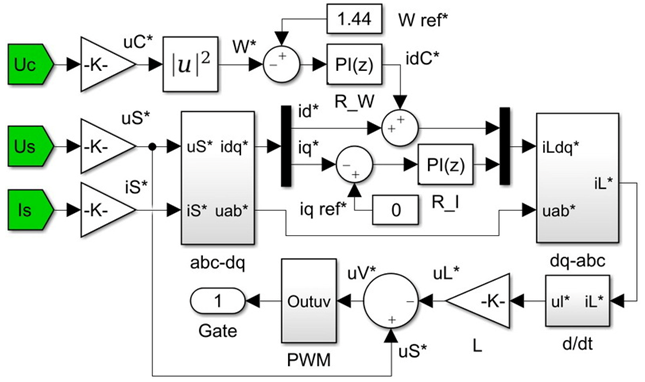Active rectifier with a fixed modulation frequency and a vector control system in the mode of bidirectional energy flow
DOI:
https://doi.org/10.20998/2074-272X.2023.6.08Keywords:
active rectifier, fixed modulation frequency, vector control system, bidirectional energy flow, vector diagram, coordinate transformation, pulse width modulationAbstract
Goal. Creation of a vector control system with improved characteristics for an active rectifier-voltage source operating in the bidirectional energy flow mode with a with a fixed modulation frequency. Methodology. The physical prerequisites for the active rectifier - voltage source operation in the system of a medium-power frequency electric drive are considered. A vector control system with a fixed modulation frequency is constructed, the principles of forming the signals acting in it and the influence on its operation of the converter power circuit parameters and the power consumed by it are considered. Mathematical modeling of the converter with the developed control system in MATLAB/Simulink made it possible to verify the correctness of the operation of the power circuit and the control system. Results. A new structure of a vector control system operating with a fixed modulation frequency is proposed, and the performance characteristics of the circuit in a wide range of changes in the magnitude and sign of the output power are obtained. The advantages of the new control system over the existing ones are shown. Originality. The physical prerequisites for the functioning of the power scheme and the vector control system of the ARVS proposed by the authors with a fixed frequency of modulation, the principles of forming the signals operating within it are considered in detail. Practical significance. New structure of the vector control system operating with a fixed modulation frequency is proposed and the advantages of the new control system over the existing ones are shown.
References
Kolar J.W., Friedli T. The Essence of Three-Phase PFC Rectifier Systems – Part I. IEEE Transactions on Power Electronics, 2013, vol. 28, no. 1, pp. 176-198. doi: https://doi.org/10.1109/TPEL.2012.2197867.
Nandhini E., Sivaprakasam A. A Review of Various Control Strategies Based on Space Vector Pulse Width Modulation for the Voltage Source Inverter. IETE Journal of Research, 2022, vol. 68, no. 5, pp. 3187-3201. doi: https://doi.org/10.1080/03772063.2020.1754935.
Jalnekar R.M., Jog K.S. Pulse-Width-Modulation Techniques: A Review. IETE Journal of Research, 2000, vol. 46, no. 3, pp. 175-183. doi: https://doi.org/10.1080/03772063.2000.11416153.
Krylov D.S., Kholod O.I. Determination of the input filter parameters of the active rectifier with a fixed modulation frequency. Electrical Engineering & Electromechanics, 2022, no. 4, pp. 21-26. doi: https://doi.org/10.20998/2074-272X.2022.4.03.
Kim H., Sul S.-K. A novel filter design for output LC filters of PWM inverters (2011) Journal of Power Electronics, 11 (1), pp. 74-81. doi: 10.6113/JPE.2011.11.1.074.
Yazdavar A.H., Azzouz M.A., El-Saadany E.F. Harmonic Analysis of Three-Phase Diode Bridge Rectifiers Under Unbalanced and Distorted Supply. IEEE Transactions on Power Delivery, 2020, vol. 35, no. 2, pp. 904-918. doi: https://doi.org/10.1109/TPWRD.2019.2930557.
Premkumar K., Kandasamy P., Vishnu Priya M., Thamizhselvan T., Ron Carter S.B. Three-phase rectifier control techniques: A comprehensive literature survey. International Journal of Scientific and Technology Research, 2020, vol. 9, no. 1, pp. 3183-3188.
Dwivedi A., Tiwari A.N. Analysis of three-phase PWM rectifiers using hysteresis current control techniques: a survey. International Journal of Power Electronics, 2017, vol. 8, no. 4, pp. 349-377. doi: https://doi.org/10.1504/IJPELEC.2017.085201.
Krylov D., Kholod O., Radohuz S. Active rectifier with different control system types. 2020 IEEE 4th International Conference on Intelligent Energy and Power Systems (IEPS), 2020, pp. 273-278. doi: https://doi.org/10.1109/IEPS51250.2020.9263226.
Soeiro T.B., Friedli T., Kolar J.W. Design and Implementation of a Three-Phase Buck-Type Third Harmonic Current Injection PFC Rectifier SR. IEEE Transactions on Power Electronics, 2013, vol. 28, no. 4, pp. 1608-1621. doi: https://doi.org/10.1109/TPEL.2012.2209680.
Wang Y. Analysis of three-phase rectifier via three different control methods and switch power loss comparison. Mankato, Minnesota State University, 2021. 93 p.
Krylov D.S., Kholod O.I. The efficiency of the active controlled rectifier operation in the mains voltage distortion mode. Electrical Engineering & Electromechanics, 2021, no. 2, pp. 30-35. doi: https://doi.org/10.20998/2074-272X.2021.2.05.
Zhang C., Yu S., Ge X. A Stationary-Frame Current Vector Control Strategy for Single-Phase PWM Rectifier. IEEE Transactions on Vehicular Technology, 2019, vol. 68, no. 3, pp. 2640-2651. doi: https://doi.org/10.1109/TVT.2019.2895290.
Liu C., Luo Y. Overview of advanced control strategies for electric machines. Chinese Journal of Electrical Engineering, 2017, vol. 3, no. 2, pp. 53-61. doi: https://doi.org/10.23919/CJEE.2017.8048412.
Kumar R., Gupta R.A., Bhangale S.V. Vector control techniques for induction motor drive: a review. International Journal of Automation and Control, 2009, vol. 3, no. 4, pp. 284-306. doi: https://doi.org/10.1504/IJAAC.2009.026778.
Zhemerov G.G., Tugay D.V. Coordinates transformation of general vectors of voltages and currents for a three-phase power supply system. Kharkiv, O.M. Beketov NUUE Publ., 2020. 200 p.
IEEE Std 519-2014. IEEE Recommended Practice and Requirements for Harmonic Control in Electric Power Systems, 2014, pp. 1-29. doi: https://doi.org/10.1109/IEEESTD.2014.6826459.

Downloads
Published
How to Cite
Issue
Section
License
Copyright (c) 2023 D. S. Krylov, O. I. Kholod

This work is licensed under a Creative Commons Attribution-NonCommercial 4.0 International License.
Authors who publish with this journal agree to the following terms:
1. Authors retain copyright and grant the journal right of first publication with the work simultaneously licensed under a Creative Commons Attribution License that allows others to share the work with an acknowledgement of the work's authorship and initial publication in this journal.
2. Authors are able to enter into separate, additional contractual arrangements for the non-exclusive distribution of the journal's published version of the work (e.g., post it to an institutional repository or publish it in a book), with an acknowledgement of its initial publication in this journal.
3. Authors are permitted and encouraged to post their work online (e.g., in institutional repositories or on their website) prior to and during the submission process, as it can lead to productive exchanges, as well as earlier and greater citation of published work.




